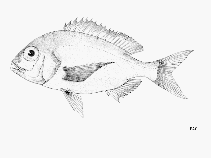Dentex angolensis Poll & Maul, 1953
Angolan dentex
Ajouter votre observation dans Fish Watcher
| Native range | All suitable habitat | Point map | Year 2050 |

|
| This map was computer-generated and has not yet been reviewed. |
| Dentex angolensis AquaMaps Data sources: GBIF OBIS |
Envoyez vos Photos et vidéos
Pictures | Images GoogleDentex angolensis
Picture by FAO
Pictures | Images GoogleDentex angolensis
Picture by FAO
Common names from other countries
Classification / Names Noms communs | Synonymes | Catalog of Fishes(Genre, Espèce) | ITIS | CoL | WoRMS | Cloffa
> Eupercaria/misc (Various families in series Eupercaria) > Sparidae (Porgies)
Etymology: Dentex: Latin, dens, dentis = teeth (Ref. 45335).
More on authors: Poll & Maul.
Etymology: Dentex: Latin, dens, dentis = teeth (Ref. 45335).
More on authors: Poll & Maul.
Environment: milieu / climate zone / depth range / distribution range Écologie
marin démersal; profondeur 15 - 300 m (Ref. 2683). Deep-water; 33°N - 17°S, 18°W - 14°E
Distribution Pays | Zones FAO | Écosystèmes | Occurrences | Point map | Introductions | Faunafri
Eastern Atlantic: Morocco to Angola.
Taille / Poids / Âge
Maturity: Lm ? range ? - ? cm
Max length : 37.5 cm TL mâle / non sexé; (Ref. 131522); 36.9 cm TL (female); common length : 25.0 cm TL mâle / non sexé; (Ref. 2683); poids max. publié: 803.60 g (Ref. 131522); poids max. publié: 803.60 g
Max length : 37.5 cm TL mâle / non sexé; (Ref. 131522); 36.9 cm TL (female); common length : 25.0 cm TL mâle / non sexé; (Ref. 2683); poids max. publié: 803.60 g (Ref. 131522); poids max. publié: 803.60 g
Occurs in various types of bottoms on the continental shelf and slope; old fish occurring in the deeper waters. Feeds mainly on crustaceans; also on fish, sometimes on mollusks and worms.
Life cycle and mating behavior Maturité | Reproduction | Frai | Œufs | Fécondité | Larves
Référence principale
Upload your references | Références | Coordinateur | Collaborateurs
Bauchot, M.-L., J.-C. Hureau and J.C. Miguel, 1981. Sparidae. In W. Fischer, G. Bianchi and W.B. Scott (eds.) FAO species identification sheets for fishery purposes. Eastern Central Atlantic. (Fishing Areas 34, 47 (in part)). volume 4. [var. pag.] FAO, Rome. (Ref. 2715)
Statut dans la liste rouge de l'IUCN (Ref. 130435: Version 2024-2)
Quasi-menacé (NT) ; Date assessed: 24 March 2011
Menace pour l'homme
Harmless
Utilisations par l'homme
Pêcheries: commercial
FAO(pêcheries: production, Résumé espèce; publication : search) | FIRMS (Stock assessments) | FishSource | Sea Around Us
Plus d'informations
Trophic ecology
Éléments du régime alimentaire
Composition du régime alimentaire
Consommation alimentaire
Food rations
Prédateurs
Éléments du régime alimentaire
Composition du régime alimentaire
Consommation alimentaire
Food rations
Prédateurs
Population dynamics
Paramètres de croissance
Max. ages / sizes
Length-weight rel.
Length-length rel.
Fréquences de longueurs
Mass conversion
Recrutement
Abondance
Paramètres de croissance
Max. ages / sizes
Length-weight rel.
Length-length rel.
Fréquences de longueurs
Mass conversion
Recrutement
Abondance
Life cycle
Reproduction
Maturité
Fécondité
Frai
Spawning aggregations
Œufs
Développement de l'œuf
Larves
Dynamique des populations larvaires
Reproduction
Maturité
Fécondité
Frai
Spawning aggregations
Œufs
Développement de l'œuf
Larves
Dynamique des populations larvaires
Anatomy
Surface branchiale
Brain
Otolith
Surface branchiale
Brain
Otolith
Physiology
Body composition
Nutrients
Consommation d'oxygène
Type de nage
Vitesse de nage
Visual pigments
Fish sound
Diseases & Parasites
Toxicity (LC50s)
Body composition
Nutrients
Consommation d'oxygène
Type de nage
Vitesse de nage
Visual pigments
Fish sound
Diseases & Parasites
Toxicity (LC50s)
Genetics
Génétique
Heterozygosity
Héritabilité
Génétique
Heterozygosity
Héritabilité
Human related
Aquaculture systems
Profils d'aquaculture
Souches
Ciguatera cases
Stamps, coins, misc.
Aquaculture systems
Profils d'aquaculture
Souches
Ciguatera cases
Stamps, coins, misc.
Outils
E-book | Guide de terrain | Générateur de fréquences de longueur | Outil de dynamique de population | Carte par point | Classification Tree
| Catch-MSY |
Articles particuliers
Télécharger en XML
Sources Internet
Aquatic Commons | BHL | Cloffa | Websites from users | FishWatcher | CISTI | Catalog of Fishes(Genre, Espèce) | DiscoverLife | ECOTOX | Faunafri | Fishtrace | GenBank(génôme, nucléotide) | GloBI | GOBASE | | Google Books | Google Scholar | Google | IGFA World Record | MitoFish | Otolith Atlas of Taiwan Fishes | PubMed | Reef Life Survey | Scirus | SeaLifeBase | Arbre de Vie | Wikipedia(aller à, chercher) | World Records Freshwater Fishing | Zoobank | Zoological Record
Estimates based on models
Preferred temperature (Ref. 115969): 14.4 - 20.6, mean 16.7 (based on 46 cells).
Phylogenetic diversity index (Ref. 82804): PD50 = 0.5001 [Uniqueness, from 0.5 = low to 2.0 = high].
Bayesian length-weight: a=0.01479 (0.01188 - 0.01841), b=3.03 (3.00 - 3.06), in cm Total Length, based on LWR estimates for this species (Ref. 93245).
Niveau trophique (Ref. 69278): 3.5 ±0.48 se; based on food items.
Résilience (Ref. 120179): Milieu, temps minimum de doublement de population : 1,4 à 4,4 années (K=0.11-0.23; tmax=7).
Fishing Vulnerability (Ref. 59153): Moderate vulnerability (41 of 100).
Climate Vulnerability (Ref. 125649): Moderate to high vulnerability (51 of 100).




